Aphrodita is a genusofmarine polychaete worms found in the Mediterranean Sea and the Atlantic Ocean.[2]
| Aphrodita | |
|---|---|

| |
| Aphrodita aculeata | |
| Scientific classification | |
| Domain: | Eukaryota |
| Kingdom: | Animalia |
| Phylum: | Annelida |
| Clade: | Pleistoannelida |
| Subclass: | Errantia |
| Order: | Phyllodocida |
| Suborder: | Aphroditiformia |
| Family: | Aphroditidae |
| Genus: | Aphrodita Linnaeus, 1758[1] |
| Type species | |
| Aphrodita aculeata Linnaeus, 1758 | |
| Species | |
|
See text | |
Several members of the genus are known as "sea mice".
The name of the genus is taken from Aphrodite, the Ancient Greek goddess of love, said to be because of a resemblance to human female genitalia.[3] The English name may derive from the animal's similarity, when washed up on shore, to a bedraggled house mouse.[4]
Aphrodita adults generally fall within a size range of 7.5 to 15 centimetres (3.0 to 5.9 in), with some growing to 30 centimetres (12 in). The body is covered in a dense mat of parapodia and setae (hairlike structures).[2] The animal lacks eyes, feeling its way with two pairs of appendages close to the mouth. Several small, bristly, paddle-like appendages provide locomotion. Aphrodita are hermaphroditic, having functional reproductive organs of both sexes, with the eggs of one individual being fertilised by the sperm of another.[5]
The spines, or setae[2] on the back of the animal are a unique feature. Normally, these have a deep red sheen. But when light shines on them perpendicularly, they flush green and blue – a "remarkable example of photonic engineering by a living organism". This structural coloration is a defense mechanism, giving a warning signal to potential predators. The effect is produced by many hexagonal cylinders within the spines, which are said to perform much more efficiently than man-made optical fibres.[6]
Aphrodita are typically scavengers.[2] However, Aphrodita aculeata is an active predator,[7] feeding primarily on small crabs, hermit crabs, and other polychaete worms such as Pectinaria.[7]
Species recognized by the World Register of Marine Species:[1]